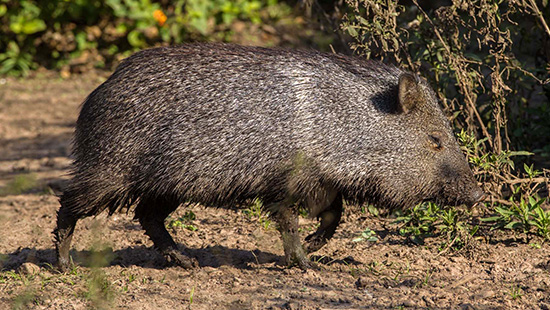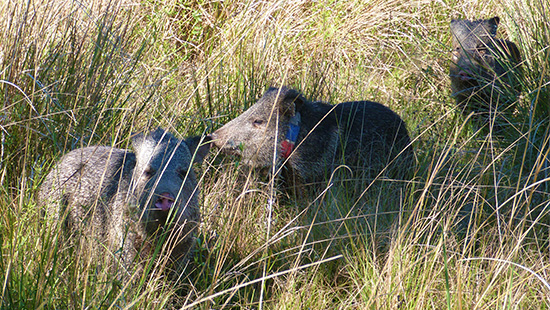Collared Peccary
Our goal is to reestablish, at least, a self sustainable population of Collared Peccaries in the Natural Reserve of Iberá.
Current status of the project (updated to February 2019): Peccaries donated by institutions from other provinces such as Tucumán, Salta, La Rioja, Córdoba and Mendoza have been released in the Rincón del Socorro Reserve, adjacent to the town of Carlos Pellegrini. About 70 animals in at least nine family groups live freely in the reserve, including more than 11 offspring born in freedom. A second population was established in the San Alonso reserve, where there are currently about 28 peccaries, including five cubs born in the reserve. In 2018, two new population nuclei were started in the San Nicolás and Carambola reserves, which currently have 16 (including four offspring born in the reserve) and five individuals, respectively.
The collared peccary: an extinct mammal in Iberá
The collared peccary (Pecari tajacu) belongs to the tayassuidae family (the same that New World wild pigs belong to) and can be found over a wide area of land ranging from the Southern United States to Central Argentina. The animal is a mammal capable of adapting to many habitats including deserts, dry forests and rainforests ranging from sea level to 2400 meters of altitude. Although the Peccary can also inhabit open grasslands, it appears to need tree or bush cover as refuge and a food source. Its diet is ample and is composed of fruits, leaves, tubers and roots, and less commonly, other animals.
The collared peccary has showed a high capacity for adaptation even in the presence of humans and in the moderate transformation of natural ecosystems by humans. For example, in the United States it is not common to see these animals within cities or suburban areas. Like other peccaries, the collared peccary is a social animal that lives in groups whose size can vary from 2 to 30 individuals. Their pasture areas range from 42 to 800 hectacres.

The collared peccary has disappeared from the Province of Corrientes (Photo: Ellen Wang)
The collared peccary is found on the red list International Union for the Conservation of Nature, catalogued as a “lower concern” species. In Argentina, the peccary is considered a low risk animal or “potentially vulnerable.” Nonetheless, the species is considered extinct in Corrientes, Entre Rios, and a fair part of Santa Fe, Southern Cordoba, North-Central Misiones, Chaco, Formosa, Tucumán, Northern Santiago del Estero, Eastern Jujuy, Salta, Southeastern Catamarca, Southern La Rioja, Eastern San Juan, Western and Northern Córdoba, San Luis and Northeastern Mendoza.
Within the Iberá region, historical presence of collared pecarries near the small patches of forest in Puerto Valle (in the Northeastern part of the Iberá Natural Reserve) is documented. However, these poplations were wiped out by hunting and clearcutting during the middle of the 20th century. French explorer D’Orbigny mentioned that the species was frequently found in the forests of Corrientes during the decade of 1820.
In Summary: The collared peccary in a very adaptable mammal that lives in groups of various sizes whose territory ranges from dozens to a few hundred hectacres of somewhat covered ecosystems. Healthy populations of the animal are still found in Argentina although it has been extinct in many regions including the Province of Corrientes.
The reintroduction of the collared peccary in Iberá: opportunities and challenges
Keeping in mind that this species has specific habitats and does not inhabit plains or simple grasslands—as would the reintroduciton of a pampas deer or marsh deer—there are only two types of habitat within the Reserve that would be ideal for their development: the paranese jungles of the North or the “espinal” (deciduous shrubland forests) in the North or South. The first type of habitat does not have public or privately owned lands that are large enough and protected enough to house the self sustainable population of the species. With respect to the Espinal, because this habitat within the Reserve or within the fiscal land is limited, the best option for the project is the private reserve Rincon del Socorro/Iberá. This CLT owned reserve has 30,000 hectacres of land dedicated to conservation of biodiversity, 40% of which contain of mosaic of espinal ecosystems with absorbant paranese forests. The rest of the land is made up of brushwood plains, which could serve as a mediocre habitat for the animals, and at the same time allow a large continual plot of land. As an extra advantage, the reserve Rincón del Socorro/Iberá is situated right next to the ranger station at Colonia Pellegrini, the largest ecotourism center of the region. This would allow tourists to observe the newly introduced animal and would convert the landscape into a more attractive tourist site.

Collared peccaries in Rincón del Socorro
One of the toughest challenges which faces the return of the species to Iberá has to do with the abundant presence of pigs, some hybridized with wild boar in the espinal region. This problem appears to be especially important in the area that surrounds the ranch Cerro Verde and other ranches situated just South of Carlos Pellegrini, including the area suggested for the reintroduction of the Peccary (Rincón del Socorro). Because of this, CLT has in effect a program to control the population of this exotic species and has been able to eliminate 2000 individuals in the last four years.
Different studies executed in the Southwestern United States have evaluated the competition between Collared Peccaries and common pigs, fundamentally comparing areas where only the Collared Peccaries live with other areas where both species live. The resluts of these studies show that both species can coexist in the same territory, although the presence of common pigs limits the abundance of Peccaries. Due to this, it is recommended to combine that action of reintroduction of the Peccary with other actions to control the abundance of the pigs.

